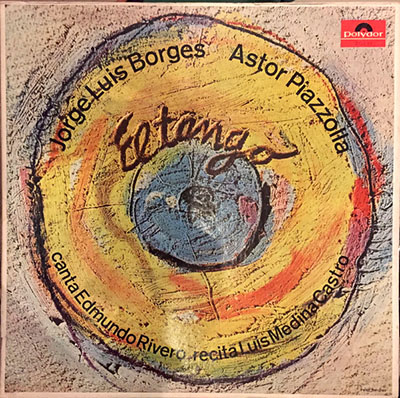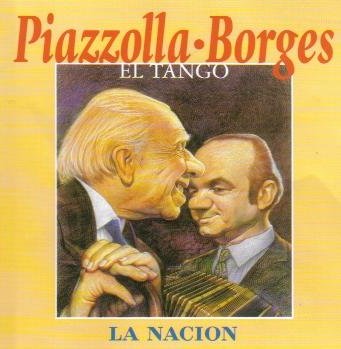Borges Music – Piazzolla “El Tango”
- At August 15, 2018
- By Great Quail
- In Borges
 0
0
Borges answered me that he didn’t know anything about music, not even differentiating between Beethoven and Juan de Dios Filiberto. He didn’t know who was who, and besides, he wasn’t interested. Then he came out giving his opinion like a great expert. I think that he was a magician. I have never read more beautiful poems than the ones Borges wrote; but in matters of music, he was deaf!
—Astor Piazzolla
El tango (1965)
 |
 |
El tango
LP: Polydor 20291 (1965)
CD: Polydor POCP-2623 (1998)
Reissue CD: La Laida (2005)
Purchase: CD [Amazon]
Online: Garden of Forking Paths [Dropbox MP3s]
Track Listing
1. El tango
2. Jacinto Chicano
3. Alguien le dice al tango
4. El títere
5. A don Nicanor Paredes
6. Oda íntima a Buenos Aires
El hombre de la esquina rosada
(A suite for 12 instruments, narrator, and singer.)
7. I. Aparición de Rosendo
8. II. Rosendo y La Lujanera
9. III. Aparición de Real
10. IV. Milonga nocturna
11. V. Bailongo
12. VI. Muerte de Real
13. VII. Epílogo
Musicians
Astor Piazzolla, Music, arrangements, and direction
Jorge Luis Borges, Texts
Edmundo Rivero, Voice
Luis Medina Castro, Reading poems
Daniel Binelli, Bandoneón
Jaime Gosis, Piano
Oscar Lopez Ruiz, Guitar
Roberto Di Filippo, Oboe
Margarita Zamek, Harp
Antonio Yepes, Percussion and vibes
Leo Jacobson, Percussion
Antonio Agri, Violin
Hugo Baralis, Violin
Mario Lalli, Viola
Jose Bragato, Cello
Kicho Diaz, Bass
The offspring of a collaboration between Jorge Borges and Astor Piazzolla, this 1965 Polydor LP was reissued on compact disc in 2005 by La Laida as part of the “Coleccion Piazzolla Esencial.” Many of the milongas themselves appeared in Borges’ 1964 Obra poética, then a year later in Para las seis cuerdas. Because all pressings of the original El tango have been deleted and are difficult to find, the Garden of Forking Paths has placed the MP3s in a convenient Dropbox for visitors to enjoy.
Despite a rocky relationship—Borges had decidedly mixed feelings about avant-garde music, and tended to enjoy more traditional tango settings; while Piazzolla admired Borges’ poetry but called him “deaf” on matters of music—El tango is an essential piece of history, the product of two artistic geniuses sharing their passion for a vanished Buenos Aires. As with many of Borges’ collaborations with non-writers, his partner recalls the eventual product more fondly, and Piazzolla’s generous liner notes provide crucial insights into his compositional process. As for Borges, he occasionally vacillated on how much involvement his side of the collaboration entailed—as stated by Piazzolla scholar John Turci-Escobar, whether Borges wrote his milongas for Piazzolla or with Piazzolla!
Excerpts from “Rescatando al Tango para una Nueva Música”
By John Turci-Escobar
Rescatando al Tango para una Nueva Música: Reconsidering the 1965 Collaboration Between Borges and Piazzolla
Varaciones Borges No. 31, 2011
Borges’s account of the project to the reporter from La Nación suggests that he was not only writing tangos and milongas for Piazzolla, but also with Piazzolla, that is, that he viewed this work as a collaborative effort: “Fue Astor Piazzolla—dice Borges—, por intermedio de un amigo común, Félix Della Paolera, quien me invitó a colaborar en esta labor” (“It was Astor Piazzolla—says Borges—, through a common friend, Félix Della Paolera, who invited me to collaborate on this work.”); “Juntos estamos creando este trabajo consistente en milongas y tangos” (“Together we are creating this work consisting of milongas and tangos”).
How Borges created these milongas and tangos together with Piazzolla, however, differs sharply from his collaborative work with Adolfo
Bioy Casares. As Piazzolla described the process to Eduardo Lagos, Borges would periodically visit the composer’s home and recite his verses into a tape recorder. Then, the musician would set them to music. Piazzolla had given a similar description of the collaborative process a few months earlier. Borges, he told the reporter, “was enthusiastic about the idea of working together, and would come to my house every day to bring me a poem or two.
[…]
Piazzolla set all but three of the poems that Borges included in [Para las seis cuerdas]. It seems unlikely that Borges presented “Los compadritos muertos” to Piazzolla since it features hendecasyllable verses, not the characteristic octosyllable versification of these tangos and milongas. Considerations of content, not form, may have excluded “¿Dónde se habrán ido?”: its use of the ubi sunt convention overlaps with that in the poem “El tango”, which appears on the first track of the album. The existence of a prior setting of “Milonga de dos hermanos” by Guastavino may explain why Piazzolla avoided recording or publishing it. Conversely, the fact that Piazzolla avoided recording or publishing “Milonga para los orientales” may explain why it was eventually set by José Basso. To my knowledge, these are the only concordances of Borges milonga texts.
Though we cannot be certain whether the texts that Borges provided to Piazzolla had already been written, we can be certain that, in the
months that preceded the album, Borges voiced enthusiasm for the project and described it as a collaborative effort. We can also be certain that, for Borges, the collaborative effort ended when he handed the verses to Piazzolla, at the end of their passage from the poet’s veins to composer’s the magnetic tape. From then on the weight of the collaboration rested solely on Piazzolla’s shoulders. One can imagine Piazzolla in his attic studio, composing at the piano to the hissing voice of Borges’s shadow. The composer may have preferred this spectral interaction since, according to Lagos, he had initially feared the responsibility of having to share preoccupations (“inquietudes”) with a poet of Borges’s stature (Lagos “Borges Con Piazzolla”). For Borges, therefore, collaborating with Piazzolla did not mean working together, but rather, an alignment in their aesthetic aspirations for tango music.
Liner Notes
By Astor Piazzolla
El tango
Polydor, 1965
Before commenting on this record’s music I would like you to know what it means to me to be a collaborator of Jorge Luis Borges. The responsibility has been big, but even larger the compensation when I learned that a poet of his magnitude identified himself with all my tunes—and it will be even greater if you share that feeling.
The music for “El hombre de la esquina rosada” was composed in march, 1960, in New York City. The work came out of an idea by choreographer Ana Itelman, who adapted sentences from Borges’ short story. The score is for narrator, singer, and 12 instruments. The musical treatment ranges from the simplest tango essence to hints of dodecaphonic music.
The music for Jorge Luis Borges’ poem “El tango” has been especially composed following and respecting its contents. This gave me the opportunity to experiment with aleatoric music in the percussion scores. The recording has been made exclusively by my quintet, which means noises you hear were made solely with their instruments. The violin produces a percussive effect by hitting the end of its handle with a ring, doing “pizzicati” with “glissé,” imitating a siren with a “glissé” on the string, imitating sandpaper with the end of the bow behind the bridge and a drum by doing “pizzicati” with the nails between two strings. The electric guitar imitates a bongo, sirens with “glissé” effects, add minor seconds and strange effects with six strings open behind the bridge. The pianist hits treble and bass notes with the palms of his hands, and with his fists on the lower notes. The bassist hits the back part of his instrument with the palm of his hand, makes “glissés” on the bass strings and hits four strings with his bow. Bandoneón imitates a bongo by hitting the box with the left annular finger. It also has, on a side, a sort of metallic güiro to be scratched with a nail. All these effects were improvised to introduce so-called aleatoric music into tango.
The milonga “Jacinto Chiclana,” the tango “Alguien le dice al tango,” and the tango-milonga “El títere” are the simplest tunes in this recording. Simple because they simply follow the spirit of Jorge Luis Borges’ poems. “Jacinto Chiclana” has the spirit of a milonga played with guitar, that is, the type of improvised milonga. “Alguien le dice al tango” can be considered, melodically and harmonically, within the 1940s style, and “El títere” could be defined as the prototype of light, joyful and “compadrón” rhythm of the turn of the century.
Due to its dramatic contents, I have composed “A don Nicanor Paredes” on an 8-bar measure of Gregorian chant and resolving the melodic part without artificial modernism—everything very simple, deeply felt and honest.
The “Oda íntima a Buenos Aires,” composed for singer, narrator, choir and orchestra, is perhaps the most audacious of all tunes for singing. Despite that, its melodic line is simple. It begins in ascending chromatic mode and ends up in descending chromatic mode.
To all . . . my thanks for having the opportunity to make this record.
 Additional Information
Additional Information
Borges & Piazzola: Tangos & Milongas
A new version of El tango was recorded in 1997 by Daniel Binelli and Jairo. It is reviewed and detailed on a separate page.
Borges reading “El tango”
A recording of Borges reading his poem, with Spanish text.
Reconsidering the Collaboration Between Piazzolla and Borges
This paper by John Turci-Escobar explores the oft-contentious “collaboration” that produced El tango. It appeared in Variaciones Borges No. 31, and is available from the Borges Center. [PDF]
Tangos al bardo: Piazzolla y Borges
This tango blog discusses El tango. [Spanish]
Astor Piazzolla’s Borges-Related Works
Astor Piazzolla Main Page
Return to the Garden of Forking Path’s Astor Piazzolla profile.
María de Buenos Aires (1968)
Piazzolla’s great tango operita, this surreal work was a collaboration with poet Horacio Ferrer. Although not directly related to Borges, its themes are often reminiscent of Borges’ early work.
A intrusa (1979)
Piazzolla’s score to A intrusa, a homoerotic Brazilian movie directed by Carlos Hugo Christensen and loosely based on Borges’ story “The Intruder.”
The Rough Dancer and the Cyclical Night (1987)
A cycle of fourteen pieces inspired by Borges’ poetry, this work was commissioned for the Hispanic American Arts Center’s production of Tango Apasionado.
Borges & Piazzolla (1996)
A modern remake of El tango, this exuberant album brings Borges’ mythical Buenos Aires to life through music, song, and narration.
Author: Allen B. Ruch
Last Modified: 12 August 2024
Borges Music Page: Borges and Music
Main Borges Page: The Garden of Forking Paths
Contact: quail(at)shipwrecklibrary(dot)com

